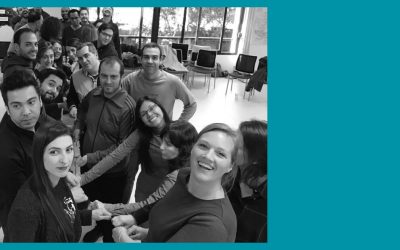Personal Leadership in a Nutshell!
Personal leadership brings us all back to the basics of human relations: know yourself first, then the other, and then the system. Due to all the abrupt changes the spread of Covid-19 brought to our daily lives and routines, we have been hastily forced to face individual limits as we were pushed out of our comfort zones on a global scale.
With these changes, what has been brought to the surface for you as a leader? How do you see yourself in a time of crisis? How do you see the other in new contexts of work and shifting goals? How do you establish relationships through uncertainty?
Personal leadership stands out as the starting step in this scenario. Knowing yourself is the first step in being able to lead. This is not a specific skill to improve and work on, this is who you are and how you relate to others.
In this article, you find links to numerous free resources on our website to help you better understand your leadership style, communicate your values assertively, and learn how to deal with frustrations. Click on the links to get to each section of the article:
- What is personal leadership?
- Who are you and how do you step into the relationship with the other?
- How do you show up with authenticity?
- How do you deal with frustration?
- How do you deal with your limits?
- And when conflicts arise?
- Boost personal growth: 3 questions to ask yourself every day
What is personal leadership?
In a nutshell, personal leadership means you learn how to master your own potential so you can lead individuals in your organization to their highest potential. Hitendra Wadhwa, professor of professional practice at Columbia Business School, quickly defines personal leadership in the video below:
Who are you and how do you step into the relationship with the other?
Now, the question is: how do you master your potential? What tools can you use and how to forge your path to this mastering?
I have been creating easy-to-implement tools to help leaders in aligning their values to their working styles. To start, you can take a snapshot of your situation.
Reflect honestly on your weekly or monthly behavior. How well are you doing from 0-10 on each segment in your life? You can download our worksheet on wellbeing to carry this out.
To understand where you stand, you can also identify your leadership style. Check the description of leadership archetypes in our article Discover yourself! Leadership starts with who you are. Which one is your archetype?
After you identified your archetype, you may realize that in some contexts, you need to adapt your style to new situations arising, to specific goals and to your team’s abilities at the moment. Check our article on situational leadership, to learn about this model and how it can help you in changing times.
As you see in the situational leadership model, connecting and listening to your team plays a crucial role in determining each context’s best approach. As Paul Tolchinsky indicates in our interview, after getting to know yourself, the next step is to understand the other, by genuinely listening.
Leadership here is about people and how we relate to each other; by being sincere and authentic.
“No matter what we’re doing on the outside, people respond primarily to how we’re feeling about them on the inside”
said Bud to Tom, The Arbinger Institute
How do you show up with authenticity?
It’s easier said than done as it takes some courage. However, to show up with authenticity, you need to be true to your personal values whilst honoring your priorities.
Juggling a set of needs, demands and traits, the focus here is on establishing connections, primarily of your values:
- connecting your set of personal values to a larger purpose than your personal interests;
- connecting your values to your habits;
- aligning your values to the energy you spend throughout the day;
- aligning your values to your team’s values.
“Alignment occurs when we transform our values into virtues. Simply identifying our primary values is not sufficient. The next step is to define more precisely how we intend to embody the values in our daily lives”
Jim Loehr, James E. Loehr, Tony Schwartz, The Full Power of Engagement
How do you deal with frustration?
I am sure that given the circumstances frustration has been part of your daily menu, as professional and personal plans have been constantly altering in this uncertain scenario.
While we create new ways of working and new personal routines, the challenges of the learning curves may become frustrating at times. These can affect how we relate to others and our ability to lead and perform. But I also believe that we can use frustration to build on and improve ourselves.
In the end of the day, emotions are self-changing agents. Just tune in and listen to them! Click on the link to download our worksheet Thriving on Emotions, to find activities to boost creativity and innovation by dealing with frustration.
How do you deal with your limits?
You can’t say YES, without saying NO to something else. That’s a given, yet easily and often ignored. Saying no, hence, is a sign of maturity. It is not easy to do so, because we want to please others and avoid conflict, but as we set priorities and align values, we need to acknowledge we are saying no to other stuff.
It’s important to recognize your patterns and become conscious of when you give in, and why, but always communicating your limits calmly, politely, and honestly. You are after all entitled to your opinions, likes, dislikes, wants and needs
Our worksheet Being assertive brings ways you can communicate authentically, setting your limits in different manners, using your body language, and clearly stating what you need, want, or believe.
To communicate and set boundaries, also check our orientations in the article No: the hardest word and in our worksheet Saying No. You’ll find ways to stop avoiding conflict and stop your tendency of pleasing people around you.
And when conflicts arise?
Just to lift a myth straight away: conflict does not equal confrontation. Check our ebook, Bounce Back, to learn about different strategies of dealing with conflicts (such as compromising and avoiding).
It’s fair to say, however, that conflict arises when communication fails. Most importantly, there’s a purpose to conflict resolution. Conflicts can help us improve, get to know our own limits and develop assertiveness and negotiation skills.
Download our worksheets with three simple steps to resolve conflicts and ways of being wise about conflict.
If conflicts are arising among your team members, you can find 5 ways of building team dynamics in our article about connecting people: understanding team dynamics for performance.
Boost personal growth: 3 questions to ask yourself every day
As part of mastering your potential for personal leadership, personal growth will always help you in advancing and improving. An easy-to-implement tool for personal growth is to ask yourself these three questions, at the end of the day:
- What are you grateful for today?
- Even in the smallest way, what made you feel proud of yourself?
- How have you created a positive impact on someone else today?
These questions are from our article on personal growth.
We encourage you to understand that your leadership skills improve as you experience and learn about your unique leadership style and own strengths. Therefore, we are writing about a few leadership related theories, approaches and techniques that may be useful to you.
Our leadership topics are a free selection by us of authors and streams of theory, without having any commercial or affiliate biases. Hopefully, our articles will inspire you to check out new stuff, or re-visit and value some of the interventions you may have already implemented.
If you are looking for workshops and training to help you navigate these changing times, don’t hesitate to get in touch. Book a free call with us, let’s talk about how to take your team to the next level.

MAIKE STOLTE
Executive Coach. Consultant. Trainer. Facilitator.
Categories
Contact us

Burnout. COVID. New Normal: How to get yourself back into balance & recover!
By now, most of us share a similar feeling: we feel drained. For months now, we have been bravely facing the Covid-19 pandemic. I think it’s fair to say that it has taken its toll on us. No matter your context, you may have been dealing with the stress of the...
Relational leadership: Influence is trusting and being trusted
We are our relationships. When we foster positive relationships, we create positive environments, develop positive projects and bring positive change to the world. This power of relationships is the base of relational leadership, focused on the leader’s ability to...
Insights From Natural Leaders: With Yasmine Khater
We can always find inspiring natural leaders close to us! In this series of interviews, I’m talking to people who have touched my soul: small business owners, neighbors, friends & colleagues. Those who inspire me to spread the wisdom & insights of our common...





0 Comments